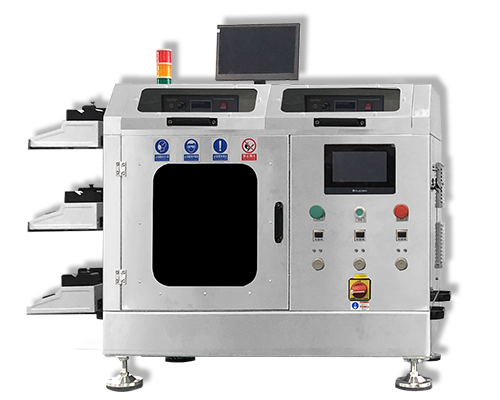Types of Cardiac Occluders
Types of Cardiac Occluders – Ultrasonic Spraying Cardiac Occluder – Cheersonic
Cardiac occluders can be broadly classified into atrial septal defect occluders, ventricular septal defect occluders, patent ductus arteriosus occluders, etc.
1. Atrial septal defect occluder:
Statistics show that the average incidence of congenital heart defects reported by different studies is 1 to 8 per 1,000 live births. An atrial septal defect (ASD) is defined as a hole in the wall between the heart’s two upper chambers (atria). This condition can occur in newborns (birth defects) and adults. The prevalence of the disorder doubles in female infants compared to male infants. Small defects may never show signs and symptoms. It may be discovered incidentally during physical examination. In adults, signs or symptoms may begin upon reaching a certain age. Associated manifestations include shortness of breath, easy tiredness, and palpitations, especially after activity. If left untreated, heart palpitations can lead to fatal conditions such as abnormal heart rhythms (arrhythmias) and heart failure.
It is still very important to be aware of warning signs and to have regular heart checkups. If an atrial septal defect is detected, it can be effectively and safely treated with transcatheter closure, a minimally invasive procedure that closes the hole with few complications and quick recovery.
2. Ventricular septal defect occluder
A ventricular septal defect (VSD) is a hole in the septum between two ventricles. Due to the higher pressure in the left ventricle, oxygen-rich blood flows back into the right ventricle and thus back into the pulmonary circulation.
3. Patent ductus arteriosus
A patent ductus arteriosus (PDA) is an abnormal communication between the aorta and pulmonary artery, allowing oxygenated (red) blood to enter the lungs. If enough blood is flowing through the PDA to cause problems, intervention may be needed. This most often occurs in settings with large or mid-sized PDAs. Indications for intervention in infancy include symptoms of unresponsiveness to medication, increased blood pressure in the lungs, and significant dilation of the heart due to excess blood flow. Usually the need for intervention in infancy becomes apparent between 6-12 months of age, and often earlier
In premature and small babies, surgery is often used to close the PDA. Surgery is performed through a thoracotomy. The chest enters from the upper left side of the back. The surgeon separates the ribs and removes the lung so the PDA can be seen. The surgeon then usually clips or ligates the PDA. Usually this is a fairly simple operation. The vast majority of infants who undergo surgery recover quickly and without significant complications.
The most common form of intervention in older infants and children is “device closure” in the catheterization laboratory. A catheter (a long, thin tube) is put into the heart through a blood vessel in the leg. The device is then placed inside the PDA, effectively shutting it down from the inside. Usually scar tissue will start to form around the device very quickly, usually within hours, to seal it permanently in place. Once the device is properly positioned, there is little risk of it coming loose. The vast majority of patients who received PDA device shutdown stayed overnight in the hospital and were discharged home the next day. They usually return to full activity within a week.
The long-term prognosis of patients with PDA closure by surgery or device closure is excellent. The vast majority of patients do not have any long-term major problems.
All patients undergoing surgery or PDA device closure must be on antibiotics for at least 6 months prior to any dental or surgical procedure. This precaution is designed to minimize the risk of any bacterial infection developing in the heart tissue. This can happen with dental work and some forms of surgery. After 6 months, the usually normal heart tissue is sufficiently sealed in place that it is no longer needed.
Ultrasonic spraying is uniquely suited for many medical coating applications due to its fine, non-clogging, repeatable spray performance and very low flow rate capability. For several years, Cheersonic has been providing ultrasonic spraying equipment for global medical equipment manufacturers. With the development of medical device technology, we will continue to design unique ultrasonic spraying solutions for medical coatings and provide high-quality medical device coatings on the market.
Cheersonic provides a variety of ultrasonic coating equipment and solutions for manufacturing industry of implantable, in interventional medical devices, the drug-eluting stents and balloon catheters. Our ultrasonic coating systems have been used to spray anti-restenosis drug eluting polymer solutions onto implantable stents. Compared to conventional two-fluid nozzles, ultrasonic nozzles can spray a more uniform drug coating that completely covers the stent without the orange peel and adhesion to a complex stent. And the coatings are much thinner than can be achieved with dip coating, saving spray material.
- Ideal for R&D and low-volume production
- Compact desktop design that is easy to move
- The material usage ratio > 95%
- Reliable, repeatable and consistent coating, uniformity of ±5%
- Max. length 100mm, max. diameter 60mm
About Cheersonic
Cheersonic is the leading developer and manufacturer of ultrasonic coating systems for applying precise, thin film coatings to protect, strengthen or smooth surfaces on parts and components for the microelectronics/electronics, alternative energy, medical and industrial markets, including specialized glass applications in construction and automotive.
Our coating solutions are environmentally-friendly, efficient and highly reliable, and enable dramatic reductions in overspray, savings in raw material, water and energy usage and provide improved process repeatability, transfer efficiency, high uniformity and reduced emissions.
Chinese Website: Cheersonic Provides Professional Coating Solutions


